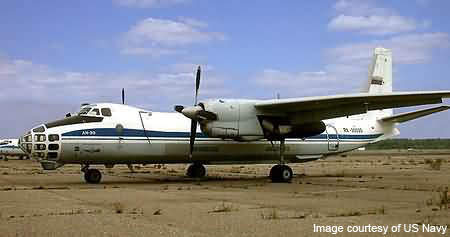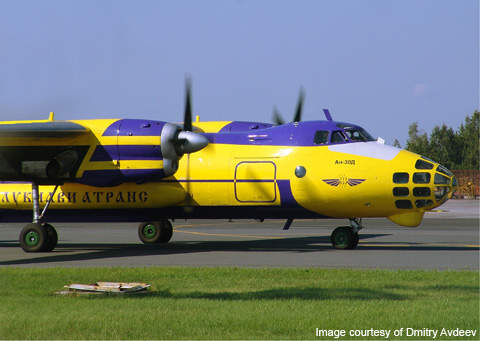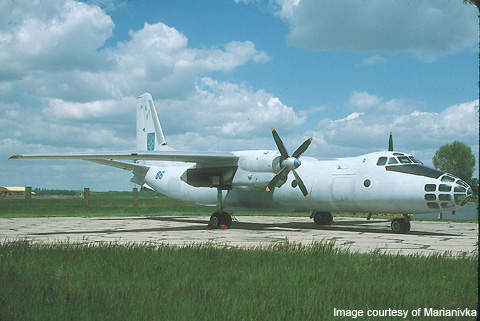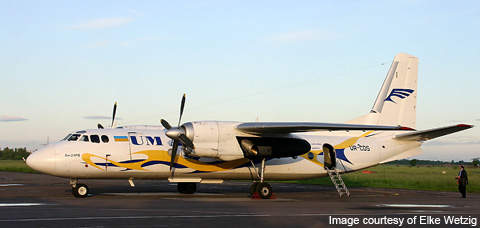The An-30 is a twin-engine, surveillance aircraft designed and manufactured by Antonov Design Bureau of Ukraine principally for the Soviet Air Force to execute cartography and aerial survey missions. Its NATO reporting name is Clank. It was derived from its predecessor An-24 transport aircraft. The production of the An-30 was terminated in 1980.
Antonov An-30 variants
The An-30 has six variants: An-30A, An-30B, An-30D Sibiryak, An-30FG, An-30M Meteorological and An-30R.
The An-30A is a civil aviation version of the An-30. About 89 An-30As were built, of which 65 were delivered to Aeroflot, six to Soviet Civil Organisations and 18 to various countries.
The An-30B is an improved version of the An-30A equipped with advance avionics and chaff dispensers.
The An-30D Sibiryak is a long range version built in 1990. It is fitted with meliorated data link system and rescue payload. It can execute ice monitoring, fisheries monitoring and transport missions.
The An-30FG is an advanced version of the An-30, designed and built for the Czech Air Force. It additionally houses western weather radar.
The An-30M is a meteorological variant which is used to try and alter weather conditions by sprinkling dry ice into atmosphere. It is equipped with eight containers weighing 130kg each to store dry ice.
The An-30R is a radiance reconnaissance configuration fitted with air sampling pods and sensors beneath the fuselage for supervising nuclear, biological and chemical warfare payloads.
Aerial cartography aircraft design
Designed with a glazed nose and raised cockpit, the An-30 can execute both military and civil operations even in adverse weather conditions. The glazed nose features navigation and communication equipment.
The aircraft is fitted with various cameras and sensors in the fuselage section to accomplish surveillance and photographic missions over a large area.
Development
The An-30 was developed in 1966 under the designation An-24FK, the first aerial survey variant of the An-24 aircraft.
The modifications included a fuselage extension, cameras and sensors installation, and a raised cockpit. The An-24FK was renamed as An-30 upon completion of maiden flight in August 1967. Production began in 1971 at the Kiev Machinery Plant in Ukraine.
The Civil Aviation Administration (CAA) certification was achieved in 1974. A total of 123 aircraft were built between 1971 and 1980, of which 23 were sold to Afghanistan, Bulgaria, China, Cuba, Czechoslovakia, Mongolia and Vietnam.
A limited number of An-30s were transformed into An-30-100 VIP transport aircraft after the collapse of the Soviet Union.
Cockpit
The An-30 features a raised cockpit which accommodates a flight crew of seven. The incorporation of navigational equipment allowed the cockpit to be raised by 41cm compared to that of the An-24. The radio operator and flight engineer sit in the rear cockpit.
The cabin is fitted with two camera operator workstations for controlling the photographic systems, crew rest area and a food locker.
The mission equipment is installed further aft of the cabin that features five camera windows in the floor. Each camera window is shut with a cover which pops out from the fuselage underside to protect the glass panels. Three cameras are mounted vertically for mapping purposes and two are installed at an angle of 28° from each other for oblique photography.
Avionics
The avionics suite installed in the An-30 includes GPS, distance measuring equipment, automatic direction finder, instrument landing system, radio altimeter and a marker beacon radio.
The aircraft is also fitted with magnetometer and microwave radiometer for long distance surveillance operations.
Engines
The An-30 is powered by two Ivenchenko Progress AI-24T turboprop engines, each producing 2,103kW of output power. The engine complies with the International Civil Aviation Organization standards.
The length and width of the engine are 2.34m and 0.67m respectively. The height is 1.07m. The dry weight is 600kg. The assigned life span is 18,000 hours.
Performance
The An-30 can fly at a maximum speed of 540km/h. The cruise speed is 430km/h. The range and service ceiling are 2,600km and 8,300m respectively.








